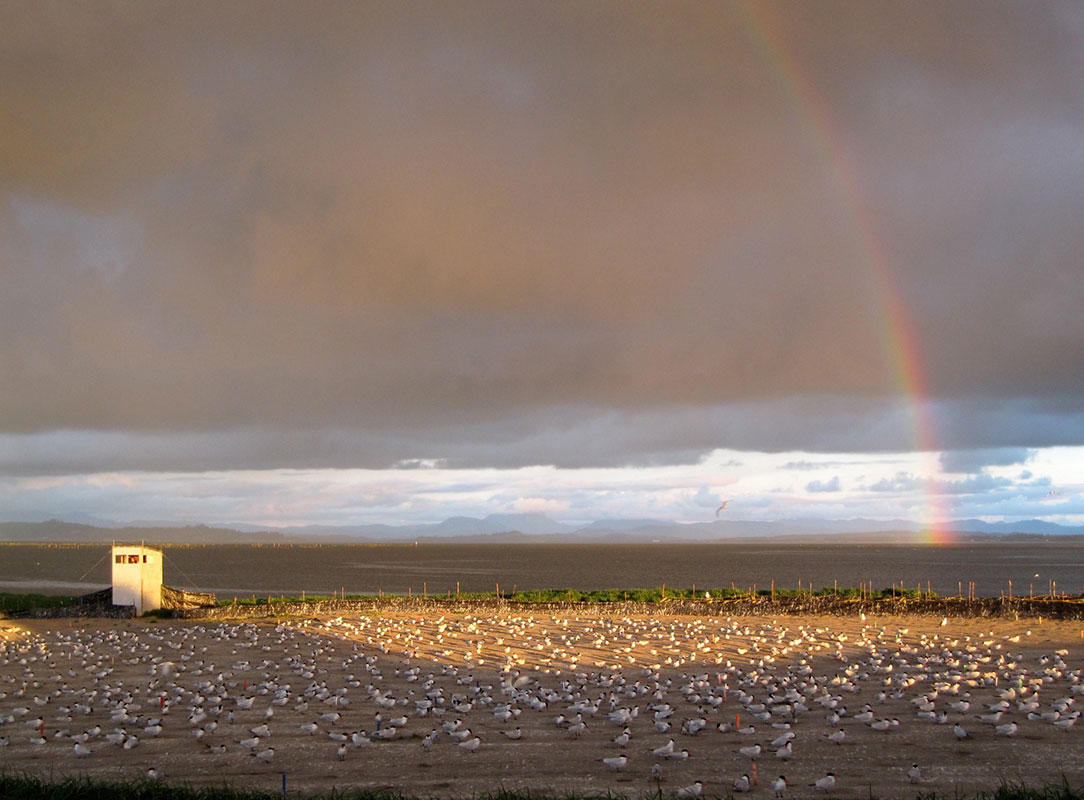 Monitoring Caspian Terns on East Sand Island, 2019
Monitoring Caspian Terns on East Sand Island, 2019
The objective of this study in 2019 was to monitor and evaluate management implemented by resource management agencies to reduce the number of Caspian terns (Hydroprogne caspia) nesting on East Sand Island in the Columbia River estuary as an approach to reducing tern predation rates on ESA-listed juvenile salmonids (Oncorhynchus spp.). During the 2019 Caspian tern breeding season on East Sand Island, we monitored tern nesting activity, assessed tern diet composition, and monitored factors that limited tern colony size and nesting success. In addition, we monitored inter-colony movements and dispersal patterns of banded Caspian terns to East Sand Island, and conducted an aerial reconnaissance flight to search for incipient tern colonies in lower Columbia River and/or estuaries on the outer coast of Washington. In 2019, the U.S. Army Corps of Engineers (USACE) prepared 1.0 acre of habitat for tern nesting on East Sand Island and installed passive nest dissuasion materials and hazed terns to prevent tern nesting outside of the designated 1.0-acre tern colony area both on East Sand Island and elsewhere in the Columbia River estuary (i.e. Rice Island) in 2019.
The management plan “Caspian Tern Management to Reduce Predation of Juvenile Salmonids in the Columbia River Estuary” was first implemented in 2008, and implementation continued during the 2019 nesting season. The objective of this management plan is to reduce the size of the Caspian tern breeding colony on East Sand Island to 3,125-4,375 breeding pairs by reducing the amount of suitable nesting habitat on East Sand Island to 1.0 acre, while preventing Caspian terns from colonizing other sites in the Columbia River estuary. One acre of nesting habitat represents 20% of the area of habitat prepared for Caspian terns on East Sand Island prior to the initiation of implementation of the management plan in 2008. Caspian terns have been provided with just 1.0 acre of nesting habitat on East Sand Island since the 2015 nesting season; however, the location of the 1.0-acre colony area has shifted in most years due to erosion along the southern edge of the colony area during winter storms. Prior to the 2019 nesting season, USACE personnel delineated 1.0 acre of prospective nesting habitat for Caspian terns on East Sand Island and prepared the colony surface for tern nesting by removing existing vegetation. First, at the end of March, a USACE contractor used heavy equipment to prepare the colony surface for Caspian tern nesting by removing dense surface vegetation from about half of the 1.0-acre area, as well as an above-ground tunnel used to access an observation blind during the 2018 breeding season, and fence-rows of landscape fabric used to dissuade terns from nesting along the eastern edge of the designated colony area in 2018. Then, in early April, USACE personnel used a disking harrow on the entire 1.0-acre colony area to break up any shallow surface vegetation that remained on the colony following colony site preparation by heavy equipment.
Caspian terns arrived at the East Sand Island colony and initiated nesting around the same time as in recent years (i.e. early to mid-April), but high predation rates on tern eggs by gulls early in the breeding season resulted in delayed hatching of the first chick and a delayed chick-rearing period in 2019 compared to previous years. The tern colony slowly grew to peak size by mid-June, when about 3,860 breeding pairs (95% c.i. = 3,667– 4,055 breeding pairs) were estimated to be nesting in the designated 1.0-acre colony area on East Sand Island. Subsequently, the number of breeding pairs on the tern colony slowly declined until the colony area was completely vacated by nesting terns in late September. The 2019 peak colony size estimate on the 1.0-acre colony area was significantly less than the 2018 peak colony size estimate (4,959 breeding pairs), and was within the range in colony size (i.e. 3,125-4,375 breeding pairs) stipulated in the management plan. In 2019, Caspian terns were displaced for nesting territories by glaucous-winged/western gulls (Larus glaucescens X L. occidentalis) on part of the eastern half of the prepared 1.0-acre colony area; consequently, Caspian terns nested on just 0.86 acres of the 1.0 acre provided. The portion of the 1.0-acre prepared tern colony area that was occupied by nesting gulls in 2019 was also used by nesting gulls in 2018.
Similar to the 2015 and 2016 breeding seasons, hundreds of pairs of Caspian terns attempted to nest on East Sand Island outside of the 1.0-acre colony area in 2019 with a sustained effort but were unsuccessful in raising any chicks to fledging. In 2015 and 2016, satellite colonies supported a total of about 810 breeding pairs and 700 breeding pairs, respectively. In 2019, Caspian terns were frequently observed in nest scrapes under passive dissuasion materials, apparently sitting on eggs. A total of about 550 breeding pairs of terns were counted in nest scrapes on several satellite colonies outside of the 1.0-acre prepared colony area at the peak of the 2019 nesting season.
At peak colony size, tern nesting density on the 1.0-acre designated colony area averaged 1.11 nests/m2 (95% c.i. = 1.06–1.17 nests/m2), slightly lower than the nesting density of 1.23 nests/m2 (95% c.i. = 1.16–1.29 nests/m2) observed in 2018, but higher than the nesting density of 0.97 nests/m2 (95% c.i. = 0.87–1.06 nests/m2) observed in 2017. Tern productivity (average number of young raised/nesting pair) in 2019 was again much lower than the long-term average, but the colony did not fail to produce any young, as it did in 2017. During the last decade, two factors have emerged as causes of low productivity at the East Sand Island Caspian tern colony: (1) reduced availability of marine forage fish in the estuary associated with high Columbia River discharge and (2) frequent colony disturbances by bald eagles (Haliaeetus leucocephalus) and associated high predation rates on tern eggs and chicks by gulls. In 2019, eagle disturbances of the tern colony were frequent and northern anchovies (Engraulis mordax, a common marine forage fish in the Columbia River estuary) were a smaller proportion of the tern diet at East Sand Island compared to most previous years, despite below average Columbia River discharge that is usually associated with high abundance of anchovies in the estuary. Northern anchovy are generally a major prey type late in the breeding season for Caspian terns nesting at the East Sand Island colony, as this marine forage fish provides a high-energy food source for fledgling Caspian terns. In 2019, a large number of nearly fledged tern chicks were depredated by gulls, especially those gulls nesting in the designated 1.0-acre colony area. High gull predation rates on older Caspian tern chicks may have been a result of the relatively low availability of anchovy for Caspian terns raising young in 2019.
The average proportion of juvenile salmonids in the diet of Caspian terns nesting on East Sand Island during the 2019 season was 33.5% (percent of identified prey items), lower than the salmonid proportion in 2015, 2017, and 2018 (37.9%, 36.0%, and 40.1%, respectively); data on diet composition were not collected in 2016. During the 2019 tern nesting season, the average proportion of juvenile salmonids in the diet of terns nesting at East Sand Island was only slightly higher than the long-term average (31.7%), measured during the 2000-2015 nesting seasons. As in previous years, estuarine and marine forage fishes (e.g., anchovy [Engraulidae], surf perch [Embiotocidae], smelt [Osmeridae], and herring [Clupeidae]) were collectively most prevalent in the tern diet, together averaging 57% of all identified bill-loads in the diet of terns nesting on East Sand Island in 2019. Although the proportion of anchovy in the diet of Caspian terns nesting at East Sand Island was well below the long-term average, herring represented a much greater proportion of the tern diet in 2019, compared to the long-term average.
Bioenergetics calculations to estimate total smolt consumption by Caspian terns nesting at East Sand Island in 2019 are currently in progress and will be included in a subsequent version of this annual report. Predation rates on specific populations of anadromous salmonids (ESUs/DPSs) by Caspian terns nesting on East Sand Island in 2019 were again investigated by recovering smolt PIT tags from the surface of the tern colony after the breeding season. That study was performed separately by the U.S. Army Corps of Engineers – Portland District, however, and those results are not presented as part of this report.
Resightings of previously banded Caspian terns on East Sand Island during the 2019 nesting season indicated that there is strong natal and breeding philopatry to the East Sand Island colony, and some terns are immigrating to the East Sand Island colony from other colonies in the Pacific Flyway. Despite low resighting effort and small sample size, a few banded terns that were observed on East Sand Island during the 2018 breeding season were detected at the Blalock Islands in 2019, suggesting that some adult terns continue to disperse from the East Sand Island colony to other colony sites in the Columbia Plateau region. There was no effort to resight banded terns at other colony locations in the Pacific Flyway outside the Columbia River basin in 2019; as such the level of connectivity between the East Sand Island colony and other colonies throughout the region during the 2019 breeding season is unknown.
We recorded almost 400 Caspian terns at locations other than East Sand Island during the aerial survey of the lower Columbia River and estuaries on the outer coast of Washington in 2019. We observed about 135 Caspian terns loafing at four different sites on the lower Columbia River, and about 245 terns loafing at five different sites in Willapa Bay and Grays Harbor. However, we did not detect Caspian tern breeding activity at any of the sites where loafing terns were detected.
-Bird Research Northwest
Click here to see full report



